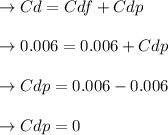
Engineering, 08.04.2020 04:28 markaylarowland8
Consider a NACA 2412 airfoil in a low-speed flow at zero degrees angle of attack and a Reynolds number of 8.9·106 . Calculate the percentage of drag from pressure drag due to flow separation (form drag). Assume a fully turbulent boundary layer over the airfoil. Assume that the airfoil is thin enough so that the skin-friction drag can be estimated by the flat-plate results discussed earlier. Now consider the same airfoil at an angle of attack of 6 degrees. Again, calculate the percentage of drag from pressure drag due to flow separation. What does this tell you about the rapid increase in drag coefficient as the angle of attack increases?

Answers: 3


Another question on Engineering

Engineering, 03.07.2019 15:10
If you were designing a bumper for a car, would you prefer it to exhibit elastic or plastic deformation? why? consider the functions of a bumper in both a minor "fender-bender" and a major collision.
Answers: 1

Engineering, 04.07.2019 18:10
Water at the rate of 1 kg/s is forced through a tube with a 2.5 cm inner diameter. the inlet water temperature is 15°c, and the outlet water temperature is 50°c. the tube wall temperature is 14°c higher than the local water temperature all along the length of the tube. what is the length of the tube?
Answers: 3

Engineering, 04.07.2019 18:20
Asimple rankine cycle uses water as the working fluid. the water enters the turbine at 10 mpa and 480c while the condenser operates at 6 kpa. if the turbine has an isentropic efficiency of 80 percent while the pump has an isentropic efficiency of 70 percent determine the thermal efficiency
Answers: 1

Engineering, 04.07.2019 18:20
Atank with constant volume contains 2.27 kg of a mixture of water phases (liquid-vapor). in the initial state the temperature and the quality are 127 °c and 0.6, respectively. the mixture is heated until the temperature of 160 oc is reached. illustrate the process in a t-v diagram. then, determine (1) the mass of the vapor in kg at the initial state, (2) the final pressure in kpa.
Answers: 3
You know the right answer?
Consider a NACA 2412 airfoil in a low-speed flow at zero degrees angle of attack and a Reynolds numb...
Questions


Mathematics, 20.11.2019 20:31




Mathematics, 20.11.2019 20:31


Business, 20.11.2019 20:31


English, 20.11.2019 20:31





Mathematics, 20.11.2019 20:31




Biology, 20.11.2019 20:31

Health, 20.11.2019 20:31





 of attack for
of attack for  :
: 





 of drag pressure due to separation flow.
of drag pressure due to separation flow. 

